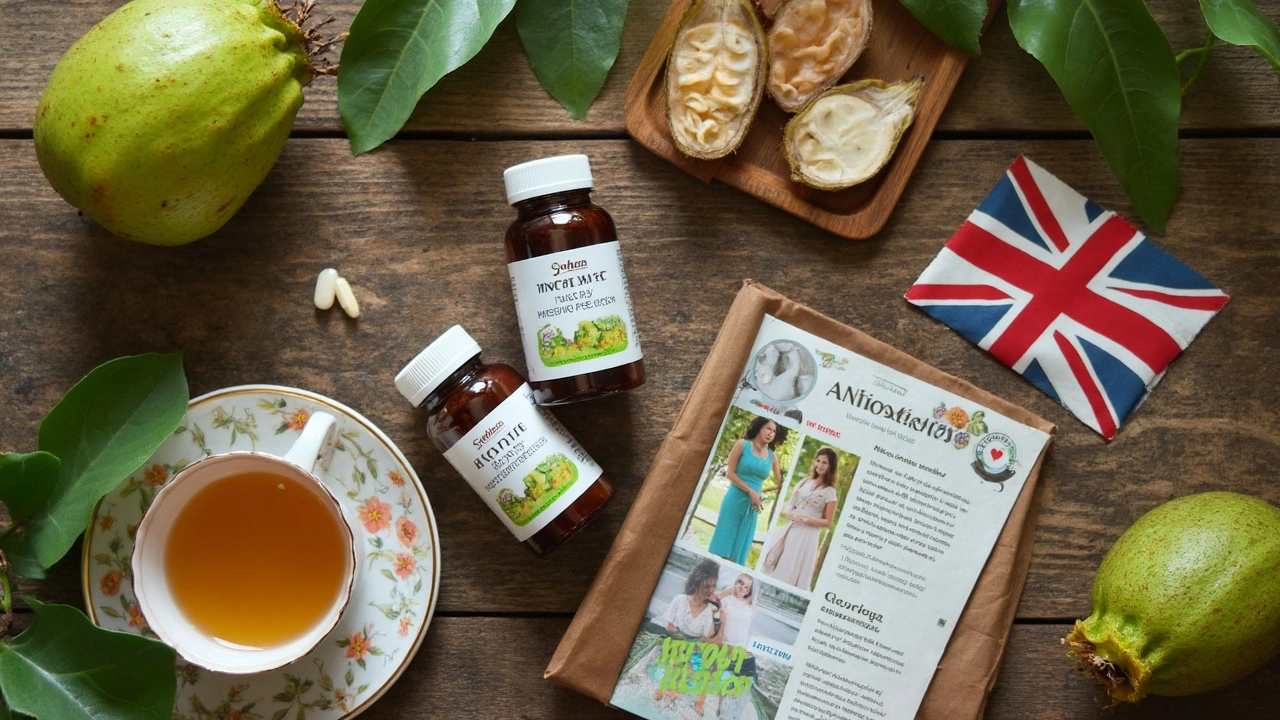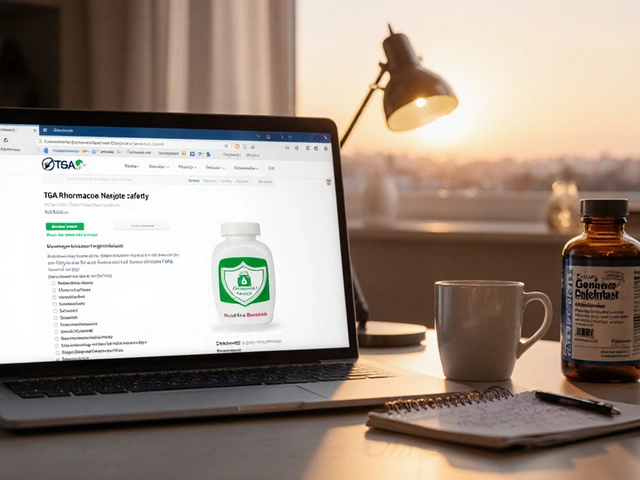Ever seen the spiky green fruit called graviola at your local health store and wondered what the buzz is about? Graviola, also called soursop, has been grabbing attention lately as more people reach for natural ways to boost their daily health. It’s not just a fruit; it’s packed into capsules, teas, powders, and even juices. Why? Because folks are hearing it might support the immune system, fight oxidative stress, and offer more wellness perks than your regular vitamin C chewables.
If you’ve got questions about what graviola actually does, how you might add it to your routine, or whether it’s even legit, you’re in the right place. There’s a lot of noise online, but it helps to know what’s real versus what’s just hype. Curious about the possible upsides, the safest ways to try it, and things you should watch out for? Let's break it all down and see if this tropical supplement deserves a spot in your kitchen cabinet.
- What Exactly Is Graviola?
- How Do People Use Graviola?
- Potential Health Benefits
- Safety, Side Effects, and Myths
- Tips for Trying Graviola Safely
What Exactly Is Graviola?
If you've ever spotted a big, green fruit covered in soft spikes at the market, that might've been graviola, also called soursop. Its Latin name is Annona muricata. Graviola is a tropical fruit that grows mostly in places like Central and South America, parts of Africa, and Southeast Asia. It's not just a fruit you eat—people have used different parts of the graviola tree, including the leaves, bark, seeds, and fruit, for a long time in traditional remedies.
The taste is kind of a mix between pineapple and strawberry with a hint of citrus, but most people today are interested in graviola for its possible health perks. Lately, you’re more likely to see graviola in powders, teas, and capsules at health shops than in the produce aisle, mostly because fresh soursop doesn’t last long out of the tropics. As a dietary supplement, it’s labeled as “natural,” which a lot of people love when they're trying to keep their wellness routine clean and simple.
Curious what’s inside? Graviola is packed with vitamin C, some B vitamins, fiber, and a load of natural antioxidant compounds called acetogenins. These have got researchers' attention for their potential health roles, which explains why graviola is making waves in the natural supplement world.
“Graviola contains a unique group of plant chemicals that may support the body in new ways we’re only beginning to understand,” says Dr. John Wilkinson, a botanist specializing in tropical plants at University College London.
Wondering how people have used graviola in the past? Traditional medicine in various cultures has turned to it for calming nerves, supporting digestion, and even fighting off infections. The interest now is about what else it might do, especially as people seek plant-based options for their wellbeing.
Here’s a quick look at the nutrients in 100 grams of fresh graviola fruit:
| Nutrient | Amount |
|---|---|
| Calories | 66 kcal |
| Vitamin C | 20.6 mg |
| Fiber | 3.3 g |
| Potassium | 278 mg |
| Carbohydrates | 16.8 g |
That’s just scratching the surface. As you keep reading, you’ll see why graviola is popping up in conversations about wellness, immune health, and so much more.
How Do People Use Graviola?
People are using graviola in all sorts of ways, way beyond just eating ripe fruit picked off the tree. You'll spot graviola in health food aisles packed into capsules, loose-leaf teas, powders, and even blended into juices and smoothies. Each type is used for slightly different reasons, but they all aim to tap into graviola’s wellness perks, like antioxidants and immune support.
The most common way folks get their daily dose is through graviola supplements—usually capsules or tablets. These are easy to take and you don’t have to worry about the sometimes sour or strong taste. For people who like something more natural, dried or fresh graviola leaves are steeped in hot water to make a tea that’s said to support relaxation and immune health. If you’re lucky enough to live near a tropical market, you might find real graviola fruit used in smoothies or even desserts, but these are less common outside tropical regions.
Some common graviola products you’ll see in stores include:
- Capsules and tablets: These pack in powdered graviola leaf or fruit.
- Teas: Dried leaves steeped in hot water for a herbal drink.
- Juices and smoothies: Usually blended with other fruits due to the sour taste.
- Powder: Easy to mix into yogurt, shakes, or recipes.
People often turn to graviola because it fits easily into daily routines—just pop a supplement with breakfast or swap your regular herbal tea for a cup of graviola. According to the National Center for Complementary and Integrative Health, “Dietary supplements containing graviola are popular despite limited evidence supporting their claimed benefits.”
“While graviola has a long history in traditional medicine, there’s no solid proof yet for its effectiveness against major diseases in humans.” — National Center for Complementary and Integrative Health
Here’s a quick look at which products are most popular in the US and how people use them:
| Product Type | Typical Use | Frequency |
|---|---|---|
| Capsules/Tablets | Swallow with water, usually once daily | High |
| Tea | Steep leaves for 5-10 minutes, drink hot or cold | Medium |
| Powder | Add into smoothies or yogurt | Low to medium |
If you’re thinking of trying graviola, start with a familiar product like capsules or tea. Always check the label for recommended doses and make sure the product comes from a reputable source. And remember, just because something is natural doesn’t mean more is better—stick to the suggested amounts on the packaging.

Potential Health Benefits
Not all fruit supplements can brag about their reputation, but graviola actually has some interesting research backing it up. First off, graviola is packed with antioxidants. These are compounds that play a big role in helping your body fight off free radicals—the things that can damage cells and speed up the aging process. A few small studies have looked at graviola extract and found that it helps reduce oxidative stress in the body. That’s a fancy way of saying it keeps your cells protected day to day.
One big reason people check out graviola is its possible support for the immune system. There’s some early evidence from lab research suggesting that it could help your body mount a defense against annoying bugs or minor infections. While human studies aren’t as common yet, cultures in South America and the Caribbean have used graviola for ages when dealing with cold season and tummy upsets.
Got inflammation? Some people turn to graviola as a natural option for calming things down. Initial studies on animals and cells show that certain compounds in graviola can dampen inflammation and discomfort. That’s why you might spot graviola extract in supplements aimed at joint or muscle health. Don’t expect miracles, but it could be part of a balanced approach to staying comfortable and active.
Here’s a quick look at the nutrients packed inside graviola:
| Nutrient | Amount (per 100g raw fruit) |
|---|---|
| Vitamin C | 20 mg |
| Potassium | 278 mg |
| Fiber | 3.3 g |
| Magnesium | 21 mg |
Another area of interest is energy. Some users say that adding graviola to their day helps them feel less run-down. This might just be a benefit of the extra vitamins and nutrients, but hey, if eating more fruit makes you feel better, it’s an easy win.
So, if you’re thinking about ways to boost antioxidant intake, give your immune health a nudge, or just want to try a new supplement that’s trending for a reason, graviola could be worth a shot. Still, actual results vary, and everyone’s body reacts differently. It’s always smart to see how your own system responds—especially if you already take other products for wellness.
Safety, Side Effects, and Myths
When you hear all the claims about graviola, it’s normal to wonder if it’s actually safe. What do you really need to watch out for? First, graviola has been eaten as a fruit for ages, especially in parts of South America and Southeast Asia. But, taking it in concentrated forms—like supplements or extracts—is a different game.
Let’s get real about side effects. Some studies have linked high doses of graviola to nerve changes similar to Parkinson’s disease symptoms. Much of this comes from consuming too much of the plant’s seeds and leaves. So, it’s a bad idea to DIY with homemade teas or extracts unless you’re 100% sure what you’re doing. Kidney and liver issues have also been reported with really high or long-term use. And if you’re pregnant or breastfeeding, best to skip it—there’s not enough research to know for sure if it’s safe.
- Don’t use homemade graviola extracts. Stick to products from reputable brands that test for quality.
- Watch out for side effects like movement changes, digestive upset, or any weird symptoms.
- If you take blood pressure meds or antidepressants, ask your doctor first. Graviola can interact with a few medications.
Here’s a quick look at some common graviola myths and the facts:
| Myth | Reality |
|---|---|
| “Graviola cures cancer.” | No solid human studies prove this. Some lab findings are interesting, but we aren’t there yet. |
| "Natural means risk-free." | Natural supplements can cause side effects or mix badly with other meds. |
| "It’s safe at any dose." | High doses may harm the liver, kidneys, or nerves. |
If you want to give graviola a try for its possible natural supplement benefits, start slow, use known brands, and listen to your body. How you react can be different from someone else. And if you’re unsure, a quick conversation with your healthcare provider is worth its weight in gold.

Tips for Trying Graviola Safely
If you’re thinking about adding graviola to your routine, don’t just grab any product off the shelf. Here’s how to use this natural supplement wisely and make the most of its benefits while staying on the safe side.
- Check the source: Pick brands that share info about where and how their graviola is grown or manufactured. Reliable brands are more likely to avoid risky contaminants or misleading claims.
- Look for third-party testing: This is a big deal with any supplement. Reputable companies will test their graviola capsules, teas, or powders for quality or impurities. If you don’t see any proof of testing, move on.
- Start small: If you’re new to graviola, begin with a low dose. Try half the recommended amount or even less. Listen to your body—upset stomach, strange headaches, or rashes are signals to stop.
- Don’t ditch real food: The best way to get your antioxidants is still from a balanced diet. Use graviola as a boost, not a replacement for fruits, veggies, or regular meals.
- Watch for meds and medical conditions: If you’re taking prescription medicine, especially blood pressure or diabetes meds, or have liver or kidney issues, talk to your doctor first. Graviola might mess with how meds work, or stress those organs.
- Skip it if you’re pregnant or breastfeeding: There’s just not enough solid info about safety in pregnancy or while nursing. It’s not worth the risk.
- Know what you're buying: Many supplements are mixed with other herbs or fillers. Read ingredient lists carefully to avoid surprises.
A 2023 survey by a U.S. health group found that about 22% of people who tried natural supplements like graviola didn’t check with a doctor first—leading to unexpected issues, especially with other medications. Play it smart and talk to your health provider if you’re not sure. Nobody wants a supplement to backfire.
| Step | Action | Reason |
|---|---|---|
| 1 | Choose tested products | Prevents contamination and low-quality ingredients |
| 2 | Start small, go slow | Helps spot any side effects early |
| 3 | Review other medications | Avoids dangerous interactions |
| 4 | Avoid while pregnant/breastfeeding | Not enough data on safety |
Wellness doesn’t mean risking it all for something new. Handle graviola with the same care you’d use for any supplement and you’ll get better, safer results.





